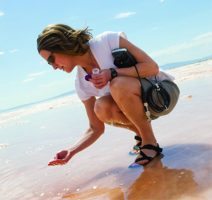Great Salt Lake is a living laboratory and bohemian refuge whose water rights need defending.
Salt Lake City is just far enough removed from the lake for which it was named that the salty shorelines are easily forgotten. But if you hike up to Ensign Peak on a clear day and look west, you will be reminded of Great Salt Lake’s place in the valley by the reflections on the horizon.
Although only an artifact of the lake it was 17,000 years ago, it still covers a variable, yet sizable, swath of the state’s territory. It is the largest lake of its kind in the western hemisphere, and one of the saltiest in the world. As such, Great Salt Lake invites the company of nature’s anomalies.
Even before the solitude of the Salt Lake valley attracted seekers of religious freedom, the mythology of Great Salt Lake attracted explorers to investigate its curiosities. For scientists today, that draw has not abated. In the words of Lynn de Freitas, executive director of the organization Friends of the Great Salt Lake, “The Great Salt Lake is an opportunity to understand something strange.”
Oolitic beaches
Not unlike the ocean coastlines, sandy beaches can be found along some shores of Great Salt Lake. But look closely, and you’ll see that the grains are spherical – not angular like more common beach sand. That round shape is an accounting of the history, origin and composition of each grain of sand.
That story begins in the Wasatch Mountains. As waters flow from those mountains into the rivers that feed Great Salt Lake, they pull with them dissolved minerals from the rocky slopes. Over a million tons of minerals flow into the lake annually. Evaporation is the lake’s only outlet for water, and this process leaves all salts and minerals behind. As minerals such as calcium become more concentrated in the lake, they begin to deposit and coalesce onto very small pieces of debris suspended in the rolling water near the shore. Layer by layer, over time this type of precipitation will produce a rounded granule.
Like coral or eggshells, Great Salt Lake sand is mostly made up of calcium carbonate. Geologists describe it as being ‘oolitic,’ which is a Greek derivative meaning ‘egg-like’; quite appropriate for the shape and composition.
Biodiversity in the brine
Although life on this planet is indifferent to our attempts to classify it, taxonomy is our way of understanding biological heritage. We recognize three main branches on the tree of life: organisms with a nucleus containing DNA wound into tightly packaged chromosomes (eukarya), organisms without such a nucleus (bacteria), and organisms that have a combination of features that are so unique that they defy classification altogether (archaea). Several species from all three domains can be found thriving below the surface of Great Salt Lake.
Of all the organisms in Great Salt Lake, the most notorious has 11 pairs of legs and two beady eyes. Artemia franciscana, better known as brine shrimp or sea monkeys, are clearly the aquatic ambassadors of the eukaryotic domain. Like brine shrimp, the larvae of brine flies are also visible in the water and also eukaryotic. Everything else is basically microscopic, including eukaryotic species of algae, protozoa, diatoms and fungi. Several species of bacteria have been identified, and they are quite abundant.
The nonconformists of the living world are the archaea, and they are comfortable in the most unconventional of environments on this planet. Naturally, Great Salt Lake is their bohemian refuge. Hundreds of various kinds of archaeal microbes are known to inhabit the lake, many of which are not yet known to exist elsewhere.
Scientists like Bonnie Baxter of Westminster College are very interested in the lake’s biodiversity. Dr. Baxter directs the Great Salt Lake Institute, where she works with students to carry out studies on such topics. “We find different species present at every location and during different years or seasons,” Baxter explained. This makes identifying all of them seem like an impossible dream. She added, “The microbial community is likely thousands deep.”
For some, the perception may be that Great Salt Lake contains nothing but sea monkeys, but there is a far more vibrant reality happening beneath the surface: a diverse network of unique species that thrive in symbiosis and relative isolation.
Confluence of chemistry and biology
Along the bottom of Great Salt Lake are scattered vast reef-like growths that are as much animal and vegetable as they are mineral. These are known as microbial bioherms, and they can be explained as clumps of symbiotic microorganisms that accumulate calcium from the water and coalesce into a hardened, living mass.

Professor of Biology
Director of Great Salt Lake Institute
Westminster College
Great Salt Lake bioherms are dark green, and can measure several feet in length and thickness. They are most easily spotted along shores of the lake in some areas where the water has receded.
Robert Baskin studied the distribution of Great Salt Lake bioherms at the University of Utah, and recently found that they cover about 386 square miles of the lakebed. That accounts for about 23% of the lake’s area. The conditions that support such bioherms are rare on Earth, and nowhere else are they more extensive than in Great Salt Lake.
According to Dr. Baskin, the bioherms are an essential part of the lake’s ecosystem. “Changes in climate, water use and the introduction of waste materials from human activities adjacent to the lake threaten the stability of the lake ecosystem and the organisms depending on it for their survival. Loss of the bioherms through changes in water chemistry or by the introduction of biocidal compounds would be catastrophic.”
Consequences of division
The 20-mile causeway that bisects Great Salt Lake, built in 1904 and upgraded in 1959, was intended for direct east and west railway transport, but in recent years it has unintentionally prevented the exchange of water between the north and south sections of the lake.
About 95% of all fresh water that flows into the lake does so south of the causeway, primarily via the Bear, Weber and Jordan rivers. Being bereft of fresh river water, the northern section (Gunnison Bay) has become its own hyper-saline ecosystem. It is now fully saturated at nearly 30% salt, while the southern section fluctuates between 10% and 15% salt depending on the temperature, water levels and location. Being completely saturated, the salt in Gunnison Bay’s water has precipitated into a crust that coats the lake bottom and spills onto the northern shorelines, painting them white.
The effects of the causeway on microbial life are more colorful. Only a fraction of the lake’s species has been able to adapt to conditions in the super-saline Gunnison Bay. And some of those microbes have a reddish hue from pigments such as beta-carotene that they produce. The resulting coloration in the north arm is a stark contrast to the south when viewed from a distance. Although such images can be interesting and even beautiful (especially when viewed contrasting the Spiral Jetty), they are also representative of ecological disruption. The bioherms that occupy Gunnison Bay are no longer active.
Construction is currently underway on upgrades to the causeway that include a 180-foot bridge intended to allow water to exchange across the divide. The Union Pacific Railroad operates the causeway and the railroad tracks that it supports. They expect to have the bridge completed by September 30 of this year.
Recently, researchers at Utah State University worked independently to predict the effects of such a bridge. They reported that in theory, opening a channel across the causeway could increase salinity in the south by up to 3.1%, and decrease salinity in the north by up to 3.5%. But this is complicated by the presence of the undissolved salt crust plating the lakebed and shoreline of Gunnison Bay due to saturation.
“Even with increased flow through the causeway, the north arm will likely maintain saturated salinity levels for several years until there is sustained years of high inflow of fresh water to the lake,” explained James White, the primary author of the Utah State University study. This process will require the addition of fresh water and some patience in order to see some level of ecological balance restored. However, the flow of fresh river water to the lake is becoming scarce.
Diminishing returns

The first measurements of water levels in Great Salt Lake were taken in 1848 on the southern edge near what is now Saltair. The water levels have been monitored meticulously ever since. Now, 168 years later, we see those levels approaching the lowest point in their recorded history.
Although drought is a persistent factor, right now the dropping water levels are amplified by increased diversion of the three major rivers that feed Great Salt Lake. A recent report from Utah State University led by Wayne Wurtsbaugh concluded that the lake’s current water level is diminished by about 11 feet due to siphoning from the Bear, Weber and Jordan rivers to support increasing water demands in the area, mostly from agriculture. By comparison, recent drought conditions have reduced the water levels by about three feet.
The shallow lake’s total area is consequently about half of what it would normally be. Dr. Wurtsbaugh is concerned that the current trend will continue. “There are no water rights to protect Great Salt Lake, so water development currently focuses solely on whether there is water upstream to divert. If future water projects reduce the supply of water to the lake, its level will continue to drop.”
The good news is that unlike drought, local water usage is something that can be managed. Reduced consumption on an individual level can help, but Dr. Wurtsbaugh says, “what we really need is conservation in the agricultural sector.”
Policies that ensure continued water supply to the lake will have immediate benefits that begin at the microbial level, and trickle up the food chain to the enormous migratory bird populations that depend on the lake’s ecosystem. In turn, this will also benefit Utah industries that likewise depend on the lake. Each year about $1.32 billion in revenue is generated locally by brine shrimp harvesting, mineral extraction and boating.
Utah is home to five national parks and countless other places that have provoked wonder and curiosity because of their singularity. The state has benefited from the preservation of these unique places. Hopefully Utah’s population will be persuaded that the capital city’s eponymous lake and its beautiful ecosystem are no less deserving of distinction and reverence.
Cyanobacteria in Great Salt Lake?
In light of the recent cyanobacteria (algal bloom) problem in Utah Lake, we asked limnologist Wayne Wurtsbaugh, professor in the Watershed Sciences Department at Utah State University, about cyanobacteria and Great Salt Lake.
With Great Salt Lake at such a low level right now, the water coming down the Jordan River mostly flows through Farmington Bay as a wide, shallow river. Algae in the water would get filtered out or degraded by nearby wetlands. Any remaining cyanobacteria would break apart as it flows out of Farmington Bay and into the highly saline Gilbert Bay.
While the cyanobacteria may not easily survive the journey from Utah Lake to Great Salt Lake’s Farmington Bay, the pollutants do—organic nutrients such as phosphate, ammonia or nitrate. “Those organic nutrients are eventually released and are used by the cyanobacteria in Farmington Bay that are tolerant of somewhat higher salinity conditions than those in Utah Lake.” Wurtsbaugh has seen huge cyanobacterial blooms in Farmington Bay that were independent of anything happening in Utah Lake.

professor in the Watershed Sciences Department at
Utah State University.
“The large Farmington Bay ‘estuary’ in Great Salt Lake receives about 50% of its inflow from wastewater treatment plants. Cyanobacteria concentrations in the bay are frequently fivefold higher than the World Health Organization’s recommendation for contact recreation.”
Robert Lawrence is a biochemist at Arizona State University, a former Utahn and a lover of Great Salt Lake.
